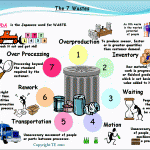This article will look at how to run an in-house 5S training course, what the specific steps should be and what should be covered and how. This article will also recommend the different materials that you may need to be able to gain the best results possible from your trainees.
Before you start your 5S in house training course.
Any 5S implementation program should follow and build on the overall aims of the business, you need to ensure that what you are trying to achieve with 5S both follows the strategy of your business. Familiarize yourself with the business objectives and create a small presentation as to how 5S can help the company to achieve those aims and the benefits of 5S, it is important that the trainees are fully aware that what they are doing will impact the overall performance and future of the company.
Select the area in which you wish to start your 5S implementation program and also select the people that you wish to have in your 5S team, they should mainly be people from the area in which you will apply 5S but feel free to add a few people from areas in which 5S will be implemented in the near future including implementing 5S for the office.
If there are no measures of performance in place for the area in which you are going to conduct your 5S training or if they are not suitable; define and begin to gather data for your 5S performance measures. These results will form a baseline against which any improvement will be measured. Involve the manager and supervisor at this stage to get their buy in and help in developing and recording this data.
Take as many photographs of the area and processes as possible to become a visual baseline for your improvements.
5S In House Training course format
My suggestions would be to use a variety of different medias in conducting your training to ensure that as many people as possible get as much information as they can. Everyone learns in different ways so the more variety you can introduce into your 5S in-house training course the better. I have included a selection of products and links further down the page to aid you in selecting the right products for your in-house 5S training course.
5S Training Introduction
This is where a short presentation regarding the aims of the company and of this specific implementation should be given, if possible have this introduction given by the CEO or another respected member of senior management to show their support for the initiative.
Introduction to the seven wastes and lean overview.
The seven wastes are an important aspect of any 5S program, after all you will be trying to eliminate these wastes within your processes. This presentation should cover what they are along with some examples. You should also cover the basics of lean manufacturing and the benefits of lean manufacturing; no more than 10 minutes for lean in general.
I would usually follow this up with a quick trip to the gemba (workplace) with pens and post-its to get the team to identify what they consider to be wasteful steps within their area; they should identify many wastes. Have them feed back the wastes to the team and use the post-its to organize them in a logical way. These can be used as a reference in later stages of 5S as you can attempt to eliminate or reduce them.
5S In-House Training
Now you should give them an overview of 5S, I normally (rather than put up many slides and talk for hours) start with a simple 5S simulation or game then a 5S DVD to run through the learning points within the game. This can be a fun introduction to 5S and will get the message over regarding what you are trying to achieve.
This should then be followed by a few slides to remind all what the first step of 5S is Seiri sort; and everyone should descend onto the workplace with the clear objective of removing all clutter from the workplace and using red tags and your quarantine area. Have a clear time limit after which you will regroup to review what has been done. As the trainer your job is to support all members of the team, challenge what they are leaving and what they are removing. This should continue until everyone is happy that all clutter is removed.
The second and third stages of 5S; 5S Seiton and 5S Seiso, should be presented with just a few slides as a reminder and once again the team should return to the workplace to begin organizing and cleaning everything there. Again have a clear time limit for each visit to the workplace and keep reviewing what people are doing and make suggestions and comparisons to the DVD etc. Also review the wastes identified earlier and see if actions undertaken have eliminated or reduced these wastes, if not try to tackle them within this stage.
If at any stage the team is starting to flounder or have nothing to do it is time to bring them back into the in-house training room and review what has been done and still needs to be done. Remember your role here is really one of facilitation, you need to allow the team to come up with the ideas for improvement not you force them onto them.
At the end of these three stages the team should create a list of actions to be conducted and any other recommendations or requests to continue the first three stages. These should be fed back to management to show what has been achieved and gain approval for any expenditure required; generally most improvements at this stage are not expensive, you will normally be looking at purchasing or manufacturing different racking styles and tooling holders and other minor changes.
Dates and responsibilities should be assigned to all of these actions and the team should plan to implement the later stages at an agreed date; dependent on the work remaining to be done.
During this break; no more than 3 or 4 weeks, the employees should continue to apply what they have learned to make additional improvements and to implement the agreed actions.
Download Free 5S Training Presentations
You can find a full range of training presentations in both PowerPoint and PDF formats for your in house training and personal education by looking at this page; 5S Presentation Downloads.
5S Training In house
The training should then recommence with a review of what has been achieved including a review of the previously agreed measures before moving onto the forth step of 5S that of 5S standardization or Seiketsu; during this portion of the training you should again present just a few slides and some examples of standardization. The team should then be split into relevant groups to begin defining standardized operations and instructions. This should only take one or two days depending on the size and complexity of the area in question.
At the end of this session I would suggest another break of around 2 weeks during which the team should continue to improve their area and the new standardized operating instructions.
Concluding your In House 5S Training
The final stage of 5S (5S Shitsuke or sustain) should then be presented to the team after a review of what has happened and improved in the previous stages and weeks. This is often the hardest stage of the training especially if the senior management has not been seen to be fully supportive of the initiative in the previous weeks.
Create a 5S story board to publicize the benefits of the implementation of 5S, show before and after photographs as well as displaying the ongoing graphs for audits and the like.
Be Prepared for your In house 5S Training
If you are going to run an in-house training course for 5S then you should ensure that you have everything that you need to do it; the following links will help you to find everything that you may need to run your 5S in house training course.
5S posters will help to put across a consistent message regarding your training.
5S Training Packages can provide you with a ready made training program for 5S.
5S Games or Simulations to allow you to simulate the improvements you will make implementing 5S.
5S Books and 5S eBooks to provide all the background and case studies you may need.
5S DVDs will help to provide clear examples of what you are trying to achieve.
5S Pocket reference cards can be used as give away resources for those participating in your 5S training.
5S Supplies such as red tags, floor marking, and shadow board kits.
If you have any advice on how to run an in house 5S training course or have any questions then please leave a comment below.



I had been given to Lead 5s in Factory.
We had success 5S from year 2009 till Apr 2012. In Oct 2012 company had given VSS to 400pax of employee.
This year with 100 employee company ask me to drive again 5S.
Our employee level knowledge in 5S is 4S, we fail in 5S (Sustain)
Kindly please advice me who the trainer can provide Refresher Trainer 5S Auditor in Malaysia.
I same time support me any material or action plan for 2015 for me to lead 5S in the Factory
Your respond is highly appreciated.
The management will have the big responsibility in this last stage sustain or maintain.The SPIRIT must be alive always so that it will never fail. Remember the 5s is an INTEGRAL part of lean mythology and when you are implementing 5S it is a TEAMWORK spirit, it should be spearheaded by the management.